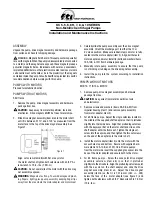
4
51984144_ed6
Performance Testing
A reconditioned paving breaker should be tested before it is sent
back to the job. Before connecting the air hose, check to see that the
lubricator used with the breaker is filled with the proper lubricating
oil. Refer to Product Information Manual 51955631 for Air Paving
Breaker Models MX60 & MX90, Lubrication, for the correct lubricating
oil specifications.
Pour a small amount (2 to 3 oz. [.06 to .09 L]) of SAE oil into the
breaker inlet, for initial lubrication. With the breaker against the work
surface, the breaker should start with less than 20 psi (1.4 bar) air
pressure and with the piston reciprocating smoothly. Let the breaker
run in slowly at reduced pressure long enough to see that it is in
good working order. If the breaker stalls, turn off the air immediately.
Stalling indicates binding caused by tight fits.
After a short period of operation, a definite rhythm should develop
and an even exhaust note will be heard. The breaker may become
warm, but should not overheat. If erratic operation continues or
stalling persists, disassemble the breaker and check for binding of
parts.
After an initial period of low pressure operation, check the
performance of a reconditioned breaker with that of a new one
by comparing both under similar conditions and with normal air
pressure. Once testing is completed, place plastic caps or plugs in all
parts to keep out dirt until the breaker is put back into service.
Troubleshooting Guide
Trouble
Probable Cause
Solution
Paving breaker will not start.
Plugged exhaust port or air passages
caused by dirt or hose particles.
1.
Dismantle breaker, clean out all ports and air passages. Keep
the air hose in good condition; never use a soft deteriorated
hose.
1.
Stuck valve due to gummy oil or
incorrect assembly.
2.
Remove valve chest parts from the breaker. Clean parts.
Never use dirty oil or oil that does not conform to the
recommended specifications.
2.
Frozen piston due to improper
lubrication.
3.
Dismantle breaker to remove piston. Repair piston by placing
in a high speed lathe and dressing with fine emery cloth.
Never run breaker without the proper lubricating oil in the
lubricating oil reservoir.
3.
Paving breaker loses power
rapidly.
Restriction in air supply line.
1.
Never allow the air supply to kink or make sharp bends.
1.
Air supply line too long.
2.
As a general rule keep the air supply line under 50 ft. (15 m).
2.
Diameter of air supply line too small.
3.
A 3/4 in. (19.1 mm) diameter air supply is recommended for
the breaker.
3.
Freezing at exhaust ports.
Excessive moisture in the air supply line.
1.
Install moisture traps in the air supply line or add anti-freeze
lubricant directly through the air inlet. Use “KILFROST”
anti-freeze lubricant or equivalent.
1.
Paving breaker lacks power.
Low air supply pressure.
1.
The air supply pressure at the tool should be 90 to 100 psi
(6.2 to 6.9 bar).
1.
Running on fronthead cushion.
2.
Keep shank fed-up to the work. Always maintain a constant
pressure when operating the breaker.
2.
Plugged air passages.
3.
Dismantle the breaker and clean out all ports and passages.
3.
Lack of lubricating oil.
4.
Maintain the proper oil level in the lubricating oil reservoir.
Steel shank must show a film of oil.
4.
Sticking valve.
5.
Remove valve chest parts from the breaker. Clean parts.
Never use dirty oil or oil that does not conform to the
recommended specifications.
5.
Overheating of the piston seat
on a new machine.
Breaker not properly broken in.
1.
Stop operating the breaker and perform initial servicing.
Never run a new breaker at full throttle until a proper bre k-in
period has been completed.
1.
Overheating of the paving
breaker after break-in period.
Running on fronthead cushion.
1.
Keep shank fed-up to work. Always maintain constant
pressure when operating the breaker .
1.
Piston not hitting the shank because of
short shank.
2.
Remove shank piece from breaker.
2.
Pulling steel at full throttle.
3.
When pulling steels, always use minimum throttle.
3.
Lack of lubrication or improper
lubricating oil.
4.
Before operating the breaker make sure the lubricating oil
reservoir is full of proper lubricant.
4.
WARNING
When using any solvent to clean parts, make sure that it meets
current safety and health standards, and that it is used in an area
that is adequately ventilated.
1. Clean all parts in a suitable solvent.
2. All parts in the housing (1), including the valve chest assembly
(7) and housing plug (6) must be examined, and all dust or dirt
particles removed.
3. Check the valve chest assembly (7) for cracks or chipping. If
damaged, replace it.
4. Replace the piston (4) when a .007 in. (.178 mm) feeler gauge can
be inserted between the piston and the housing bore.
5. Check the throttle valve parts for wear. Make sure the throttle
valve is moves freely.
Inspection and Repair
Summary of Contents for MX Series
Page 6: ... 51984144_ed6 Maintenance Records Date Run Time Hours Work Performed Qty Work By ...
Page 7: ...51984144_ed6 Date Run Time Hours Work Performed Qty Work By ...
Page 8: ... 51984144_ed6 Date Run Time Hours Work Performed Qty Work By ...
Page 9: ...Notes ...
Page 10: ...Notes ...
Page 11: ...Notes ...
Page 12: ...ingersollrandproducts com 2014 Ingersoll Rand ...






























